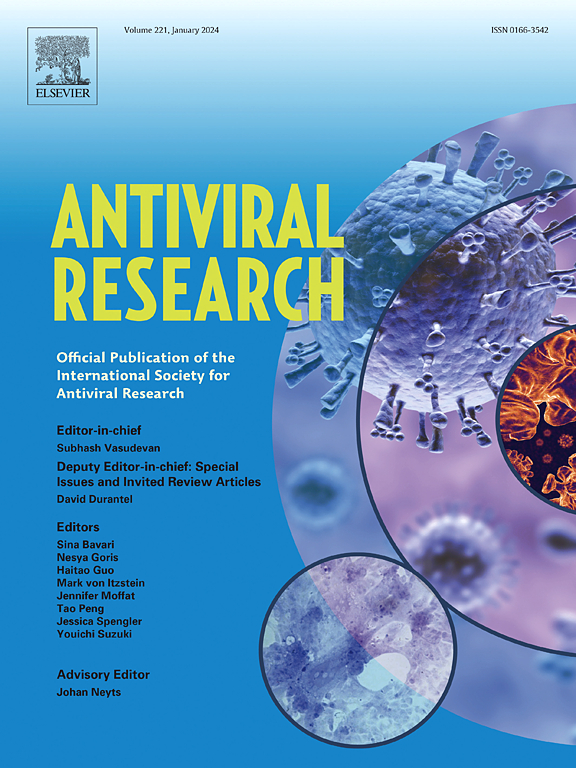Antiviral mechanisms and preclinical evaluation of amantadine analogs that continue to inhibit influenza A viruses with M2S31N-based drug resistance
IF 4.5
2区 医学
Q1 PHARMACOLOGY & PHARMACY
引用次数: 0
Abstract
To better manage seasonal and pandemic influenza infections, new drugs are needed with enhanced activity against amantadine- and rimantadine-resistant influenza A virus (IAV) strains containing the S31N variant of the viral M2 ion channel (M2S31N). Here we tested 36 amantadine analogs against a panel of viruses containing either M2S31N or the parental, M2 S31 wild-type variant (M2WT). We found that several analogs, primarily those with sizeable lipophilic adducts, inhibited up to three M2S31N-containing viruses with activities at least 5-fold lower than rimantadine, without inhibiting M2S31N proton currents or modulating endosomal pH. While M2WT viruses in passaging studies rapidly gained resistance to these analogs through the established M2 mutations V27A and/or A30T, resistance development was markedly slower for M2S31N viruses and did not associate with additional M2 mutations. Instead, a subset of analogs, exemplified by 2-propyl-2-adamantanamine (38), but not 2-(1-adamantyl)piperidine (26), spiro[adamantane-2,2′-pyrrolidine] (49), or spiro[adamantane-2,2′-piperidine] (60), inhibited cellular entry of infectious IAV following pre-treatment and/or H1N1 pseudovirus entry. Conversely, an overlapping subset of the most lipophilic analogs including compounds 26, 49, 60, and others, disrupted viral M2-M1 protein colocalization required for intracellular viral assembly and budding. Finally, a pilot toxicity study in mice demonstrated that 38 and 49 were tolerated at 30 mg/kg. Together, these results indicate that amantadine analogs act on multiple, complementary mechanisms to inhibit replication of M2S31N viruses.
金刚烷胺类似物继续抑制m2s31n型耐药甲型流感病毒的抗病毒机制和临床前评价
为了更好地管理季节性和大流行性流感感染,需要开发具有增强抗金刚烷胺和金刚乙胺耐药甲型流感病毒(IAV)毒株活性的新药,这些毒株含有病毒M2离子通道(M2S31N)的S31N变体。在这里,我们测试了36种金刚烷胺类似物对含有M2S31N或亲本M2S31野生型变体(M2WT)的一组病毒的作用。我们发现几种类似物,主要是那些具有相当大的亲脂加合物的类似物,可以抑制多达三种含有M2S31N的病毒,其活性至少比金刚乙胺低5倍,而不抑制M2S31N的质子电流或调节内体ph。而在传代研究中,M2WT病毒通过建立的M2突变V27A和/或A30T迅速获得对这些类似物的抗性。M2S31N病毒的耐药发展明显较慢,且与额外的M2突变无关。相反,一类类似物,如2-丙基-2-金刚烷胺(38),而不是2-(1-金刚烷基)哌啶(26)、spiro[金刚烷-2,2'-吡咯烷](49)或spiro[金刚烷-2,2'-哌啶](60),在预处理和/或H1N1假病毒进入后抑制感染性IAV进入细胞。相反,最亲脂类似物的重叠亚群,包括化合物26、49、60等,破坏了细胞内病毒组装和出芽所需的病毒M2-M1蛋白共定位。最后,在小鼠中进行的初步毒性研究表明,38和49在30 mg/kg的剂量下是耐受的。总之,这些结果表明金刚烷胺类似物通过多种互补机制抑制M2S31N病毒的复制。
本文章由计算机程序翻译,如有差异,请以英文原文为准。
求助全文
约1分钟内获得全文
求助全文
来源期刊

Antiviral research
医学-病毒学
CiteScore
17.10
自引率
3.90%
发文量
157
审稿时长
34 days
期刊介绍:
Antiviral Research is a journal that focuses on various aspects of controlling viral infections in both humans and animals. It is a platform for publishing research reports, short communications, review articles, and commentaries. The journal covers a wide range of topics including antiviral drugs, antibodies, and host-response modifiers. These topics encompass their synthesis, in vitro and in vivo testing, as well as mechanisms of action. Additionally, the journal also publishes studies on the development of new or improved vaccines against viral infections in humans. It delves into assessing the safety of drugs and vaccines, tracking the evolution of drug or vaccine-resistant viruses, and developing effective countermeasures. Another area of interest includes the identification and validation of new drug targets. The journal further explores laboratory animal models of viral diseases, investigates the pathogenesis of viral diseases, and examines the mechanisms by which viruses avoid host immune responses.
 求助内容:
求助内容: 应助结果提醒方式:
应助结果提醒方式:


